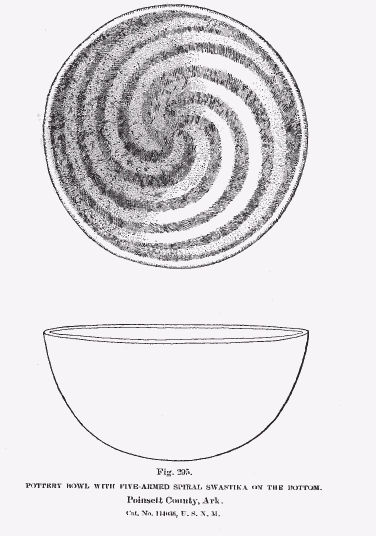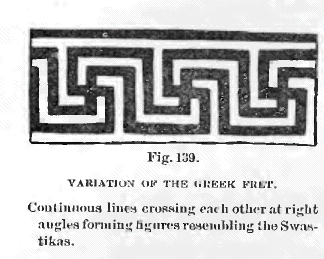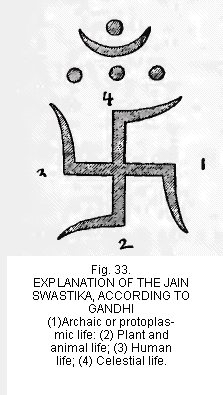

The Swastika
The Migration Of Symbols

 It is argued by Zmigrodzki that the
Swastika on so many specimens, especially the Trojan spindle-whorls, having
been made regularly, sometimes turning one way, sometimes another, sometimes
square, other times curved, goes to show the rapidity with which the sign
was made, that it did not require an artist, that its use was so common
that it had become a habit and was executed in a rapid and sketchy manner,
as evidenced by the appearance of the marks themselves upon the whorls.
He likens this to the easy and unconsidered way which men have of signing
their names, which they are able to do without attention. He likens it
also to the sign of the cross made by Roman Catholics so rapidly as to
be unnoticed by those who are unaware of its significance. With this line
of argument, Zmigrodzki reasons that the Swastika was in its time confined
to common use and thus he accounts for the number of ill-formed specimens,
but not for the great number, the mass of those well formed and well drawn.
Instead of the Swastika being a sign easily made, the experience of the
writer is the contrary.
It is argued by Zmigrodzki that the
Swastika on so many specimens, especially the Trojan spindle-whorls, having
been made regularly, sometimes turning one way, sometimes another, sometimes
square, other times curved, goes to show the rapidity with which the sign
was made, that it did not require an artist, that its use was so common
that it had become a habit and was executed in a rapid and sketchy manner,
as evidenced by the appearance of the marks themselves upon the whorls.
He likens this to the easy and unconsidered way which men have of signing
their names, which they are able to do without attention. He likens it
also to the sign of the cross made by Roman Catholics so rapidly as to
be unnoticed by those who are unaware of its significance. With this line
of argument, Zmigrodzki reasons that the Swastika was in its time confined
to common use and thus he accounts for the number of ill-formed specimens,
but not for the great number, the mass of those well formed and well drawn.
Instead of the Swastika being a sign easily made, the experience of the
writer is the contrary.  A
simple cross like the Latin, Greek, St. Andrew's, and other common forms
may be very easy to make, but a really good specimen of the Swastika is
difficult to make. Any one who doubts this had only to make the experiment
for himself, and make correctly such a specimen as fig. 9. While it may
be easy enough to make the Greek cross with two lines of equal length
intersecting each other at right angles, and while this forms a large
proportion of the Swastika, it is at its conclusion that the trouble of
making a perfect Swastika begins. It will be found difficult, requiring
care and attention, to make the projecting arms of equal length, to see
that they are all at the same angle; and if it is bent again and again,
two or three turns upon each other, the difficulty increases. If a person
thinks that the Swastika, either in the square or the ogee curves or the
spiral volutes, is easy to make, he has but to try it with paper and pencil,
and, if that is his first attempt, he will soon be convinced of his
A
simple cross like the Latin, Greek, St. Andrew's, and other common forms
may be very easy to make, but a really good specimen of the Swastika is
difficult to make. Any one who doubts this had only to make the experiment
for himself, and make correctly such a specimen as fig. 9. While it may
be easy enough to make the Greek cross with two lines of equal length
intersecting each other at right angles, and while this forms a large
proportion of the Swastika, it is at its conclusion that the trouble of
making a perfect Swastika begins. It will be found difficult, requiring
care and attention, to make the projecting arms of equal length, to see
that they are all at the same angle; and if it is bent again and again,
two or three turns upon each other, the difficulty increases. If a person
thinks that the Swastika, either in the square or the ogee curves or the
spiral volutes, is easy to make, he has but to try it with paper and pencil,
and, if that is his first attempt, he will soon be convinced of his  error.
The artist who drew the spirals for this paper pronounced them to be the
most difficult of all; the curves are parabolic, no two portions of any
one are in the same circle, the circle continually widens, and no two
circles nor any two portions of the same circle have the same center.
To keep these lines true and parallel, the curve regular, the distances
the same, and at the same time sweeping outward in the spiral form, the
artist pronounces a most difficult work, requiring care, time, and attention
(fig. 295). Even the square and meander Swastikas (figs. 10, 11)require
rule and angle to make them exact. All this goes to show the intention
of the artist to have been more or less deliberate; and that the object
he made was for a special purpose, with a particular idea, either as as
symbol, charm, or ornament, and not a meaningless figure to fill a vacant
space.
error.
The artist who drew the spirals for this paper pronounced them to be the
most difficult of all; the curves are parabolic, no two portions of any
one are in the same circle, the circle continually widens, and no two
circles nor any two portions of the same circle have the same center.
To keep these lines true and parallel, the curve regular, the distances
the same, and at the same time sweeping outward in the spiral form, the
artist pronounces a most difficult work, requiring care, time, and attention
(fig. 295). Even the square and meander Swastikas (figs. 10, 11)require
rule and angle to make them exact. All this goes to show the intention
of the artist to have been more or less deliberate; and that the object
he made was for a special purpose, with a particular idea, either as as
symbol, charm, or ornament, and not a meaningless figure to fill a vacant
space. Yet
it is practically this difficult form of the cross which appears to have
spread itself through the widest culture areas, extending almost to the
uttermost parts of the earth. All this is foundation for the suggestion
that the Swastika was not the result of duplicate invention or independent
discovery, that it is not an illustration of parallelism in human thought,
but that it was transmitted from person to person, or passed from on country
to another, either by the migration of its people, by their contact or
communication, or by the migration and transmission of the symbol and
the sign itself. Pushing the argument of the difficulty of its making,
to account for the rarity of the design, it is alleged that in modern
times the Swastika is practically unknown among Christian peoples. It
passed out of use among them nigh a thousand years ago and has been supplanted
by every other imaginable geometric form. The fret, chevron, herringbone,
crosses, and circles of every kind, spirals, volutes, ogees, moldings,
etc., have all remained in used since Neolithic
Yet
it is practically this difficult form of the cross which appears to have
spread itself through the widest culture areas, extending almost to the
uttermost parts of the earth. All this is foundation for the suggestion
that the Swastika was not the result of duplicate invention or independent
discovery, that it is not an illustration of parallelism in human thought,
but that it was transmitted from person to person, or passed from on country
to another, either by the migration of its people, by their contact or
communication, or by the migration and transmission of the symbol and
the sign itself. Pushing the argument of the difficulty of its making,
to account for the rarity of the design, it is alleged that in modern
times the Swastika is practically unknown among Christian peoples. It
passed out of use among them nigh a thousand years ago and has been supplanted
by every other imaginable geometric form. The fret, chevron, herringbone,
crosses, and circles of every kind, spirals, volutes, ogees, moldings,
etc., have all remained in used since Neolithic  times,
but no Swastika. The latest use mentioned in the literature upon this
subject appears to have been in the arch-Episcopal chair in the cathedral
at Milan, which bears the three ancient Christian crosses, the Latin cross,
the monogram of Christ, and the Swastika, of which the first and last
are carved in alternates around the pedestal of the chair. Yet the knowledge
of the Swastika has been perpetuated in some countries and its use has
not died out all over the world; therefore, examples of its use in modern
times should be noted in order to prevent misapprehension and contradiction.
The double Greek fret made with two continuous lines (fig. 139) forms
a pseudo Swastika at each intersection, although we have seen that this
is not real but only an apparent Swastika (p. 783).
times,
but no Swastika. The latest use mentioned in the literature upon this
subject appears to have been in the arch-Episcopal chair in the cathedral
at Milan, which bears the three ancient Christian crosses, the Latin cross,
the monogram of Christ, and the Swastika, of which the first and last
are carved in alternates around the pedestal of the chair. Yet the knowledge
of the Swastika has been perpetuated in some countries and its use has
not died out all over the world; therefore, examples of its use in modern
times should be noted in order to prevent misapprehension and contradiction.
The double Greek fret made with two continuous lines (fig. 139) forms
a pseudo Swastika at each intersection, although we have seen that this
is not real but only an apparent Swastika (p. 783).  This
is used in modern times by carpet and linen weavers as borders for carpets
and tablecloths, and by tile makers in similar decoration. The Swastika
mark has continued in use among the Orientals; the Theosophists have adopted
it as a seal or insignia; the Japanese (fig. 30), the Koreans (p. 799),
the Chinese (fig. 31), the Jains (figs. 33, 34),
and , among the North American Indians, the Navajo (pl.
17), and those of the Kansas Reservation (pl.
15 and 16). It is not used
by European peoples in modern times, except in Lapland and Finland. The
National Museum has lately received a collection of modern household and
domestic utensils from Lapland, some of which bear the marks of the cross
and one a churn, the lid of which bears a possible Swastika mark. Through
the kindness of Professor Mason and Mr. Cushing, I have received a
This
is used in modern times by carpet and linen weavers as borders for carpets
and tablecloths, and by tile makers in similar decoration. The Swastika
mark has continued in use among the Orientals; the Theosophists have adopted
it as a seal or insignia; the Japanese (fig. 30), the Koreans (p. 799),
the Chinese (fig. 31), the Jains (figs. 33, 34),
and , among the North American Indians, the Navajo (pl.
17), and those of the Kansas Reservation (pl.
15 and 16). It is not used
by European peoples in modern times, except in Lapland and Finland. The
National Museum has lately received a collection of modern household and
domestic utensils from Lapland, some of which bear the marks of the cross
and one a churn, the lid of which bears a possible Swastika mark. Through
the kindness of Professor Mason and Mr. Cushing, I have received a << Previous Page Next Page >>
© 2004-2007 Northvegr.
Most of the material on this site is in the public domain. However, many people have worked very hard to bring these texts to you so if you do use the work, we would appreciate it if you could give credit to both the Northvegr site and to the individuals who worked to bring you these texts. A small number of texts are copyrighted and cannot be used without the author's permission. Any text that is copyrighted will have a clear notation of such on the main index page for that text. Inquiries can be sent to info@northvegr.org. Northvegr™ and the Northvegr symbol are trademarks and service marks of the Northvegr Foundation.

|